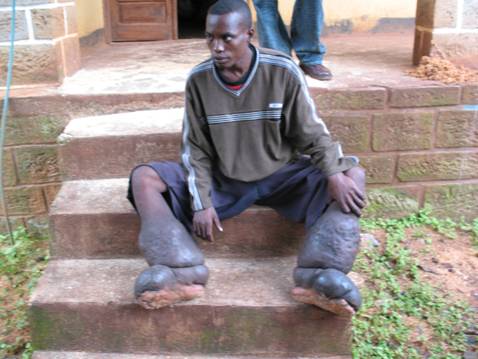2009-12-15
DNA Genotek recently announced that an international team of researchers used the Oragene product to investigate a genetic link to podoconiosis, a neglected tropical disease. Podoconiosis is a disease occurring in individuals exposed to red clay soil derived from volcanic rock in tropical Africa, Central America and Northwest India. Podoconiosis occurs in barefooted farmers and other occupational groups where exposure to volcanic soil is common. Characteristics of the disease include swelling of the foot and lower leg which progresses to elephantiasis, having a severe impact on mobility and quality of life for those affected. The photograph on the right shows a patient with an advanced case of the disease.

Dr. Melanie Newport, Professor in Infectious Diseases and Global Health, Brighton and Sussex Medical School, UK and Dr. Gail Davey, Associate Professor, School of Public Health, Addis Ababa University co-lead the study. They found that Oragene was very well suited to this type of research.
Dr. Newport stated, "Collecting DNA samples in rural Ethiopia would be a tremendous challenge without Oragene. The saliva-based product was easy-to-use and completely non-invasive, which allowed us to collect from as many individuals as possible. The product provides high quality DNA and is stable at ambient temperatures, which is ideal for collection in a tropical environment."
We feel this is important news to share for a number of reasons:
- Podoconiosis affects more people than HIV infection, TB or filarial elphantiasis in the affected regions.
- Podoconiosis is a neglected and under-researched condition.
- An estimated one million Ethiopians are afflicted with podoconiosis. This creates a huge economic burden in endemic areas as it often leads to unemployment for those who suffer from severe cases.
- The burden of the disease has been shown to fall in the most economically active sector of the population, having a severe impact on productivity.
- Social stigma against people with podoconiosis is rife.
- People with podoconiosis lose 45% of total productive work days when compared to unaffected people, costing a single zone of 1.5 million inhabitants more than US$16 million per year. Podoconiosis thus contributes significantly to poverty in affected communities.
If you take a moment to consider the facts above, it's obvious that the scale of the problem is overwhelming in affected regions. However, podoconiosis is unique in that it is an entirely preventable non-communicable disease. Primary prevention of podoconiosis consists of avoidance of prolonged contact between the skin and irritant soils. This may be achieved with use of robust footwear. Secondary prevention takes the form of training in foot hygiene and use of socks and shoes. Compression bandaging is effective in reducing the size of the soft type of swelling. Progression can be completely averted if these measures are strictly adhered to, but compliance must be life-long as there is no cure for the condition.

If you'd like to learn more, you can visit The Mossy Foot Treatment and Prevention Association web site (podoconiosis is also referred to as mossy foot disease). You'll find more information on the condition and learn how you can help.
In the meantime, we'll be waiting to hear from Drs. Newport and Davey as they complete the analysis of the DNA samples. When they identify the gene or genes involved, we'll be sure to let you know here in The Genetic Link.


